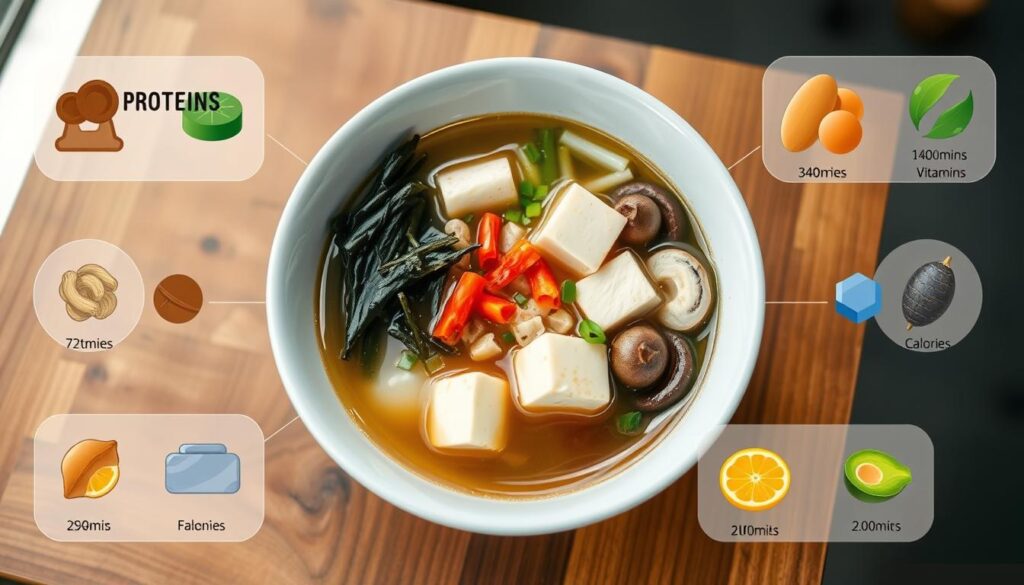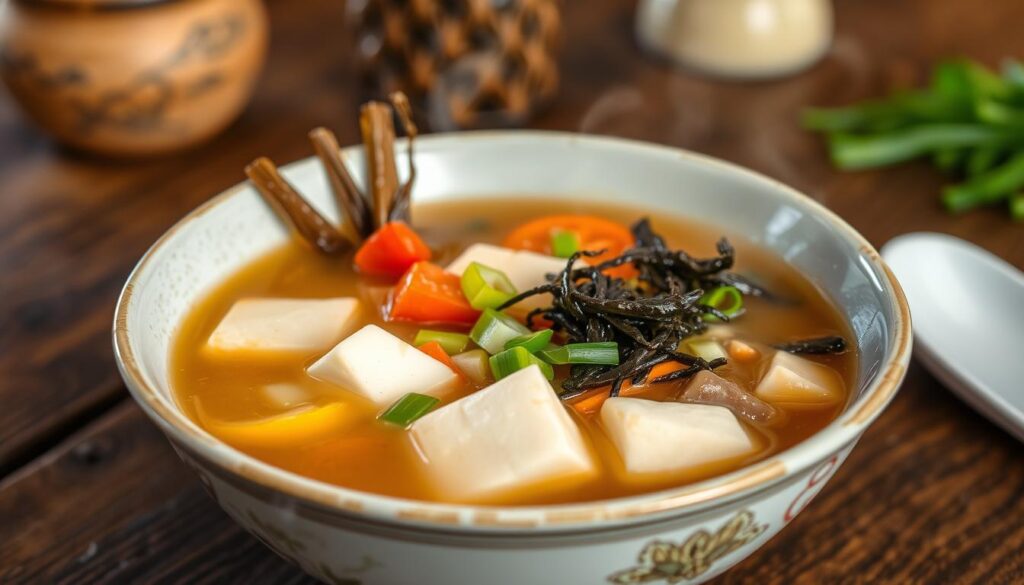Table of Contents
Exploring miso soup reveals its deep history and cultural importance. It’s a key dish in many cuisines globally. Knowing about miso soup calories and nutrition facts helps us see its value.
Miso soup has roots in Japan but is loved worldwide. Learning about its calories and health benefits helps us choose it wisely. It’s a nutritious and tasty addition to our diets.
Key Takeaways
- Understanding miso soup calories is essential for a healthy diet
- Miso soup nutrition facts reveal its numerous health benefits
- Miso soup is a traditional Japanese dish with a rich history
- Calorie count and nutrition facts are crucial in determining the value of miso soup
- Incorporating miso soup into your diet can have significant health benefits
- Miso soup is a delicious and nutritious addition to any meal
Understanding Miso Soup: A Traditional Japanese Staple
Miso soup is a beloved dish in Japan, loved for centuries. It’s made with miso paste and dashi, a Japanese broth. To make a low calorie miso soup, you can add tofu, seaweed, and green onions.
A healthy miso soup recipe combines these ingredients with spices. The fermentation of miso paste gives it a special flavor and health benefits. You can enjoy it as a starter or side dish, paired with rice or noodles.
Learning about miso soup and using a healthy miso soup recipe lets you make a tasty, nutritious soup at home. Whether you like a low calorie miso soup or a traditional one, there are many choices.
| Ingredient | Calories per serving |
|---|---|
| Tofu | 80-100 |
| Seaweed | 20-50 |
| Green onions | 10-20 |
| Miso paste | 50-100 |
| Dashi | 0-10 |
Miso Soup Calories: Breaking Down the Numbers
Understanding miso soup calories is key. You might ask, how many calories are in miso soup? The answer varies based on ingredients, portion sizes, and cooking methods. A bowl of miso soup usually has 50 to 200 calories, which is quite low.
Here are some things that affect miso soup calories:
- Ingredients: The type and amount of miso paste, dashi broth, and added items like tofu or seaweed change the calorie count.
- Portion sizes: Bigger servings mean more calories.
- Cooking methods: How you make your miso soup, like using more oil or adding calorie-rich ingredients, also matters.
Knowing how many calories in miso soup helps with diet planning. It’s good for weight loss or keeping a healthy lifestyle. Being aware of miso soup calories lets you choose better.
By thinking about these factors and watching miso soup calories, you can enjoy this Japanese dish. It fits well with your dietary goals.
The Complete Nutritional Profile of Miso Soup
Miso soup is a traditional Japanese dish that’s full of vitamins and minerals. It’s a great source of vitamins A and K, and minerals like copper and manganese. This makes it a nutritious choice for your meals.

Essential Vitamins and Minerals
- Vitamin A: important for healthy vision and immune function
- Vitamin K: crucial for blood clotting and bone health
- Copper: plays a role in the production of red blood cells
- Manganese: involved in the metabolism of carbohydrates and amino acids
Protein Content in Miso Soup
Miso soup is a good source of protein. This is thanks to the miso paste, which is made from fermented soybeans. It’s a great option for those who want to eat more protein.
Sodium Levels and Considerations
Miso soup does contain a lot of sodium. But, it’s worth considering its overall nutritional value. Using a healthy miso soup recipe and watching your portion sizes can help manage sodium intake.
Probiotics and Gut Health Benefits of Miso Soup
Exploring miso soup reveals its role in supporting digestive health and weight loss. It’s rich in probiotics, which help keep your gut microbiome balanced. Adding miso soup to your meals can lead to better digestion and a stronger immune system.
The fermentation in miso soup makes it a probiotic powerhouse. This can greatly benefit your gut health. Some key advantages include:
- Improved digestion and nutrient absorption
- Boosted immune system
- Increased production of certain vitamins
- Support for miso soup weight loss efforts
Understanding miso soup’s probiotic benefits shows its value for your health. It’s great for improving digestion or aiding in miso soup weight loss. Adding it to your diet can be a smart move.
| Benefit | Description |
|---|---|
| Probiotics | Supports gut health and digestion |
| Weight Loss | Can aid in weight loss efforts |
| Immune System | Boosts immune system function |
How Miso Soup Supports Your Weight Loss Journey
Starting your weight loss journey? Adding miso soup to your diet can help. It’s full of benefits and can be a great part of your meals. Look for a low-calorie, nutrient-rich miso soup.
Here are some ways miso soup can aid in weight loss:
- It helps control hunger and keeps you full, making dieting easier.
- The protein, fiber, and other nutrients in miso soup can speed up your metabolism.
- It’s low in calories, perfect for those watching their weight.
To maximize miso soup’s weight loss benefits, eat it at the right times. Enjoy it as a snack or part of your meal. It’s a tasty, healthy choice for your diet.
Making the Perfect Low-Calorie Miso Soup at Home
To make a tasty and healthy miso soup, you need some key ingredients and tools. First, get low-sodium miso paste, dashi broth, and your favorite protein like tofu or chicken. You’ll also need a pot, a strainer, and a whisk.
For a low calorie miso soup, choose ingredients that are both tasty and good for you. A healthy miso soup recipe often includes veggies like spinach, carrots, and green onions. It also has lean proteins. Adding seaweed or mushrooms can make the soup even better.

Essential Ingredients and Equipment
- Low-sodium miso paste
- Dashi broth
- Protein source (tofu, chicken, etc.)
- Vegetables (spinach, carrots, green onions, etc.)
- Pot
- Strainer
- Whisk
By following a simple recipe and using the right ingredients, you can make a delicious and nutritious low calorie miso soup. It’s great for a healthy meal or snack. With a bit of practice, you can make healthy miso soup recipes that fit your taste and diet.
Common Mistakes to Avoid When Preparing Miso Soup
When making miso soup, watch out for common mistakes. These can change the miso soup calories and miso soup nutrition facts. One big error is adding too much salt. This boosts sodium and can mess up the soup’s taste.
Another mistake is cooking the ingredients too long. This can make them lose nutrients and become unappetizing. Also, using bad miso paste can ruin the soup’s taste and miso soup nutrition facts.
To steer clear of these errors, follow these tips:
- Choose top-notch miso paste and ingredients for the best flavor and nutrition.
- Keep an eye on the salt and adjust it to keep miso soup calories low.
- Cook the ingredients just right to keep nutrients and texture good.
Knowing these common mistakes and how to avoid them helps make a tasty and healthy miso soup. You can make it fit your taste and diet needs, with the right miso soup calories and miso soup nutrition facts.
Incorporating Miso Soup into Your Daily Diet Plan
To enjoy the benefits of the miso soup diet, start by adding it to your daily meals. Miso soup is packed with nutrients that support your health. For weight loss, it’s important to control how much you eat. You can use it as a base for other soups or as a side dish.
Here are some meal planning ideas to get you started:
- Use miso soup as a base for other soups, such as vegetable or noodle soups
- Add miso soup to your favorite recipes, such as stir-fries or salads
- Use miso soup as a side dish to complement your meals, such as with grilled chicken or fish
Remember, portion control is key for weight loss benefits. A typical serving size is about 1 cup. Adjust the size based on your calorie needs and goals. Adding miso soup to your daily meals can boost your health and well-being.
| Miso Soup Serving Size | Calories | Protein |
|---|---|---|
| 1 cup | 100-150 | 2-3g |
| 2 cups | 200-300 | 4-6g |
Additional Ingredients to Enhance Your Miso Soup’s Nutritional Value
To make a healthy miso soup, add different ingredients. Start with vegetables like spinach, carrots, and green onions. They are full of antioxidants and fiber. These add-ons not only make your soup taste better but also give you important vitamins and minerals.
Adding protein-rich foods like tofu, tempeh, or edamame is another good idea. These ingredients increase the soup’s protein, making it more filling. When you look at miso soup nutrition facts, you’ll see these additions make a meal balanced and nutritious.
Here are some healthy miso soup recipes:
- Adding wakame seaweed for extra umami flavor and nutrients
- Incorporating shiitake mushrooms for their immune-boosting properties
- Using lean protein sources, such as chicken or fish, for added protein
By using these ingredients and learning about miso soup nutrition facts, you can make a tasty and healthy meal. It will meet your dietary needs and tastes.
| Ingredient | Nutritional Benefit |
|---|---|
| Spinach | Rich in antioxidants and fiber |
| Tofu | High in protein and iron |
| Wakame Seaweed | Rich in umami flavor and nutrients |
Conclusion
Incorporating miso soup into your daily diet can change your health for the better. It’s low in miso soup calories but packed with nutrients. Plus, it’s good for your gut thanks to its probiotics.
Adding miso soup to your meals can boost your digestion and immune system. It might even help with weight management. You can enjoy it as a meal, use it in other soups, or mix it into recipes. It’s a versatile and nutritious choice for any diet.
To get the most from miso soup, eat it in moderation. Try different types and mix-ins. Listen to how your body reacts. By making miso soup a part of your routine, you’ll enjoy its many benefits.
FAQ
How many calories are in a typical serving of miso soup?
A typical 1-cup serving of miso soup has about 55-100 calories. This depends on the ingredients and how much you eat.
What are the nutritional benefits of miso soup?
Miso soup is full of vitamins, minerals, and antioxidants. It’s rich in protein, fiber, and probiotics. These can help your gut health and immune system.
Can miso soup help with weight loss?
Yes, miso soup can aid in weight loss. It’s low in calories and can make you feel full. This helps manage your appetite and support weight goals.
What are the different types of miso paste and how do they affect the flavor of miso soup?
There are many types of miso paste, like white, yellow, red, and brown. The flavor of the soup changes with the type of miso. White miso is mild, while red miso is robust and salty.
How can I make a low-calorie miso soup at home?
To make low-calorie miso soup, use low-sodium miso paste. Choose low-calorie veggies like mushrooms, spinach, or bok choy. Avoid tofu or meat. Adjust the portion size to control calories.
What are some common mistakes to avoid when making miso soup?
Don’t use too much miso paste or overcook the soup. Make sure to dissolve the miso well. Watch the sodium by avoiding too much salt or soy sauce.
How can I incorporate miso soup into my daily diet?
Miso soup is versatile. Enjoy it as a starter or side dish. Use it as a soup base or pair it with grains, veggies, or protein.

